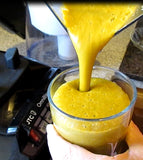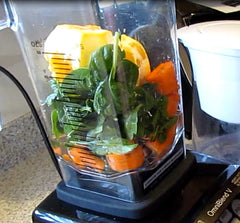Can Raw Smoothies Improve Eye Health? December 09 2013
Brightly colored fruits and vegetables make delicious smoothies and also contribute to healthy eyes. Vitamins in these raw foods can protect against such conditions as night blindness, eye infections, and degenerative eye diseases. Although supplements are plentiful and widely marketed, health professionals stress the importance of a good diet. Making raw smoothies with your high performance blender is one way to give your diet a boost while taking care of your vision.
Seeing Better with Vitamin A
Children and pregnant and lactating women who have a vitamin A deficiency are at a risk for blindness. In fact, night blindness is the first symptom of an eye disease that may be linked to insufficient vitamin A in the diet. This vitamin nourishes cells in the retina that are responsible for creating nerve impulses triggered by light. Vitamin A also helps to relieve dry eyes and can guard against glaucoma. Look for yellow, orange, red and green vegetables and fruits for good sources of vitamin A. Examples include: spinach, pumpkin, kale, collard greens, cantaloupe, and apricot. Vitamin A is a fat-soluble nutrient and will build up in the body. It is important to get enough, but not to get too much of this vitamin. The recommended daily intake for girls who are more than 10 years of age and women is 800 mcg; boys older than 10 and men should take 1,000 mcg a day.
Vitamin D Lowers Risks
Vitamin D in sufficient amounts lowers the risk of eye infections as well as protecting overall immunity and helping you maintain good vision. Most recently, studies published in leading ophthalmology journals show a link between vitamin D deficiency and an increased risk of macular degeneration, a progressive disease resulting in blindness. Fortified juices, daily milk and almond milk are good sources of vitamin D and can easily be used in your smoothies and sauces. Daily requirements of this fat-soluble vitamin vary by age. Those below age 50 should consume 200 IU, men and women between 51 and 70 need 400 IU, and those older than 70 require 600 IU.
Vitamin E and Your Immunity
Vitamin E is an antioxidant and can be found in sweet potatoes and nuts, as well as vitamin-fortified cereals and peanut butter. It helps the immune system and plays a role in reducing the risk of blindness in later years. Foods that are good sources of vitamin E include kiwi, avocado, peach, pumpkin, and papaya. All can be used found in soup, smoothie or sauce recipes. Vitamin E, which is also a fat-soluble vitamin, must come from either supplements or diet because the body cannot manufacture it through any biological function. The recommended daily requirement for vitamin E is 22 IU for men and women. Women who are lactating need 28.5 IU every day, and children between the ages of 4 and 8 require 10.5 IU.
Vitamin C: The Other Antioxidant
Many nutritionists and medical professionals consider this vitamin a good source for making overall immunity stronger. It is also thought to improve eye health because it can protect against eye infections. Other advantages are said to include antioxidant and anticarcinogenic properties. Among the raw fruits and vegetables high in vitamin C are peas, strawberries, oranges, kale, broccoli, carrot, apricot, papaya and collard green. The recommended daily dosage of this water-soluble vitamin is 75 mg for women and 65 mg for men
Eye Support with Lutein and Zeaxanthin
Colorful vegetables contain these two important substances, which are referred to as xanthophylls. Both lutein and zeaxanthin are present at high levels in the human eye. Specifically, these compounds are found in the macula and provide an antioxidant benefits that keep the cells in the eyes healthy. Zeaxanthin can protect the photoreceptors in the eye as well as the retina and macula. Some studies *** indicate that these two substances play a larger role in reducing the incidence of macular degeneration than vitamins E or C. Studies suggest *** that adults should eat foods that contain 6 mg of lutein and zeaxanthin a day. If you are in the habit of making raw smoothies with richly colored fruits and vegetables, the changes are good that you are giving your body the right amount of vitamins and other nutrients for optimal eye health. Rather than seeking out supplements and researching to find credible manufacturers, it is far easier to make smoothies using some of the colorful fruits, vegetables along with fortified milk or juices.
References ***
www.mdsupport.org
http://www.luteininfo.com

 It seems that there are virtually thousands of supplements and ingredients on the market that claim to protect against nearly every imaginable ailment and affliction. To add to this confusion, websites selling supplements are coming online at an incredibly fast rate. If you are looking for the right supplements for bone health, a good place is a basic list of vitamins and minerals, the proper daily dosage based on age, and how you can derive the most benefit from them. ...Or, you could try a concoction of your own... A Calcium Smoothie?
It seems that there are virtually thousands of supplements and ingredients on the market that claim to protect against nearly every imaginable ailment and affliction. To add to this confusion, websites selling supplements are coming online at an incredibly fast rate. If you are looking for the right supplements for bone health, a good place is a basic list of vitamins and minerals, the proper daily dosage based on age, and how you can derive the most benefit from them. ...Or, you could try a concoction of your own... A Calcium Smoothie? Calcium Smoothie
Calcium Smoothie